Poole Ch.P., Jr. Handbook of Superconductivity
Подождите немного. Документ загружается.

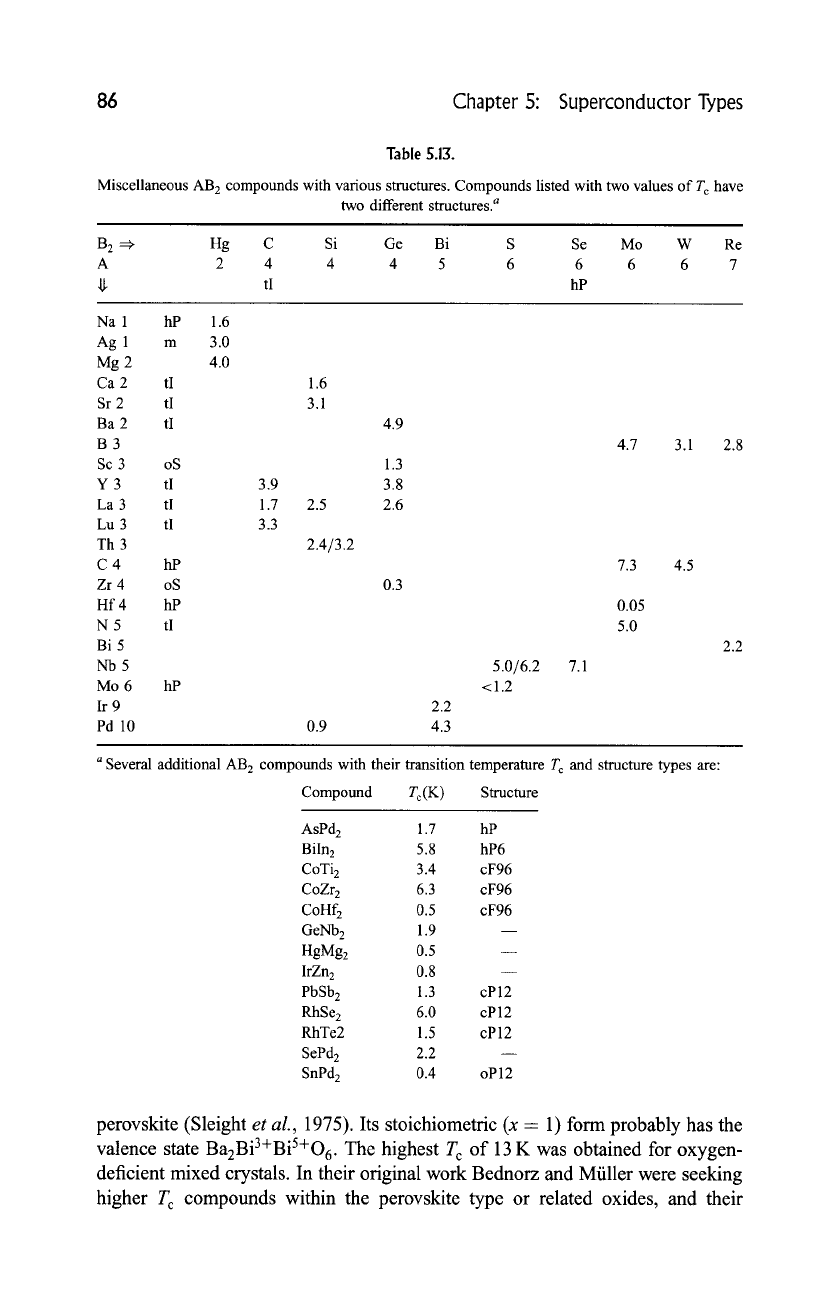
86
Chapter S: Superconductor Types
Table 5.13.
Miscellaneous AB 2 compounds with various structures. Compounds listed with two values of T c have
two different structures, a
B 2 =, Hg C Si Ge Bi S Se Mo W Re
A 2 4 4 4 5 6 6 6 6 7
tI hP
Na 1 hP
Ag 1 m
Mg 2
Ca 2 tI
Sr 2 tI
Ba 2 tI
B3
Sc 3 oS
Y 3 tI
La 3 tI
Lu 3 tI
Th 3
C 4 hP
Zr 4 oS
Hf 4 hP
N 5 tI
Bi 5
Nb5
Mo 6 hP
Ir 9
Pd 10
1.6
3.0
4.0
3.9
1.7
3.3
1.6
3.1
2.5
2.4/3.2
4.9
1.3
3.8
2.6
0.3
2.2
0.9 4.3
5.0/6.2 7.1
<1.2
4.7 3.1 2.8
7.3 4.5
0.05
5.0
2.2
a Several additional AB 2 compounds with their transition temperature T c and structure types are:
Compound T c (K) Structure
AsPd2 1.7 hP
BiIn 2 5.8 hP6
CoTi 2 3.4 cF96
CoZr 2 6.3 cF96
CoHf 2 0.5 cF96
GeNb 2 1.9
HgMg 2 0.5
IrZn 2 0.8
PbSb 2 1.3 cP12
RhSe 2 6.0 cP12
RhTe2 1.5 cP12
SePd2 2.2
SnPd 2 0.4 oP12
perovskite (Sleight
et al.,
1975). Its stoichiometric (x - 1) form probably has the
valence state BazBi3+Bis+O6 . The highest T c of 13 K was obtained for oxygen-
deficient mixed crystals. In their original work Bednorz and Mfiller were seeking
higher Tr compounds within the perovskite type or related oxides, and their
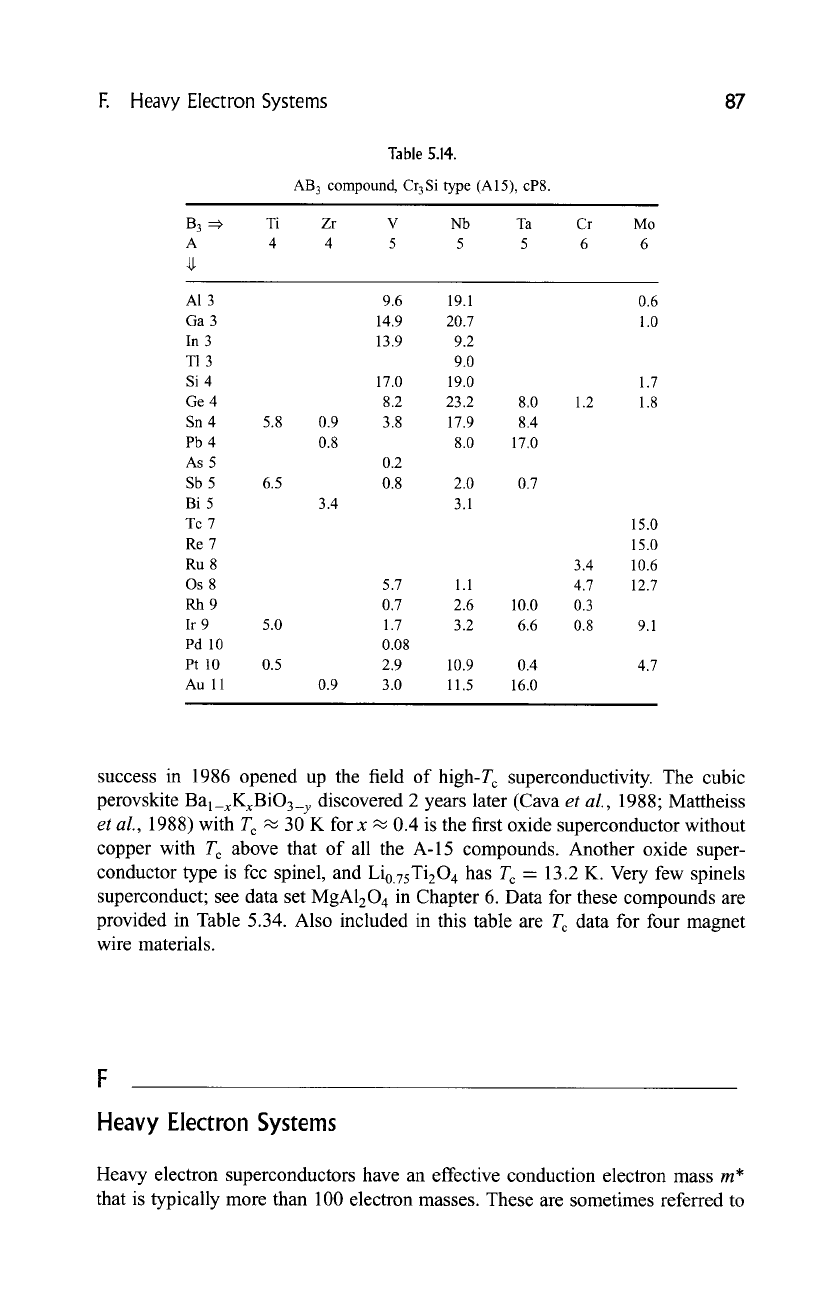
F.
Heavy Electron Systems
87
Table
5.14.
AB 3 compound, Cr3Si type (A15), cP8.
B 3 :=~
A
Ti Zr V Nb Ta Cr
Mo
4 4 5 5 5 6 6
A1 3
Ga 3
In 3
T1 3
Si4
Ge 4
Sn 4
Pb 4
As 5
Sb 5
Bi 5
Tc 7
Re 7
Ru 8
Os
8
Rh9
Ir 9
Pd 10
Pt 10
Au 11
5.8
9.6 19.1
14.9 20.7
13.9 9.2
9.0
17.0 19.0
8.2 23.2 8.0
0.9 3.8 17.9 8.4
0.8 8.0 17.0
0.2
6.5 0.8 2.0 0.7
3.4 3.1
0.6
1.0
1.7
1.2 1.8
15.0
15.0
3.4 10.6
5.7 1.1 4.7 12.7
0.7 2.6 10.0 0.3
5.0 1.7 3.2 6.6 0.8 9.1
0.08
0.5 2.9 10.9 0.4 4.7
0.9 3.0 11.5 16.0
success in 1986 opened up the field of high-T c superconductivity. The cubic
perovskite
Bal_xKxBiO3_y
discovered 2 years later (Cava
et aL,
1988; Mattheiss
et al.,
1988) with T c ~ 30 K for x ~ 0.4 is the first oxide superconductor without
copper with T c above that of all the A-15 compounds. Another oxide super-
conductor type is fcc spinel, and Li0.ysTi204 has T c -- 13.2 K. Very few spinels
superconduct; see data set MgAI204 in Chapter 6. Data for these compounds are
provided in Table 5.34. Also included in this table are T c data for four magnet
wire materials.
Heavy Electron Systems
Heavy electron superconductors have an effective conduction electron mass
m*
that is typically more than
100
electron masses. These are sometimes referred to
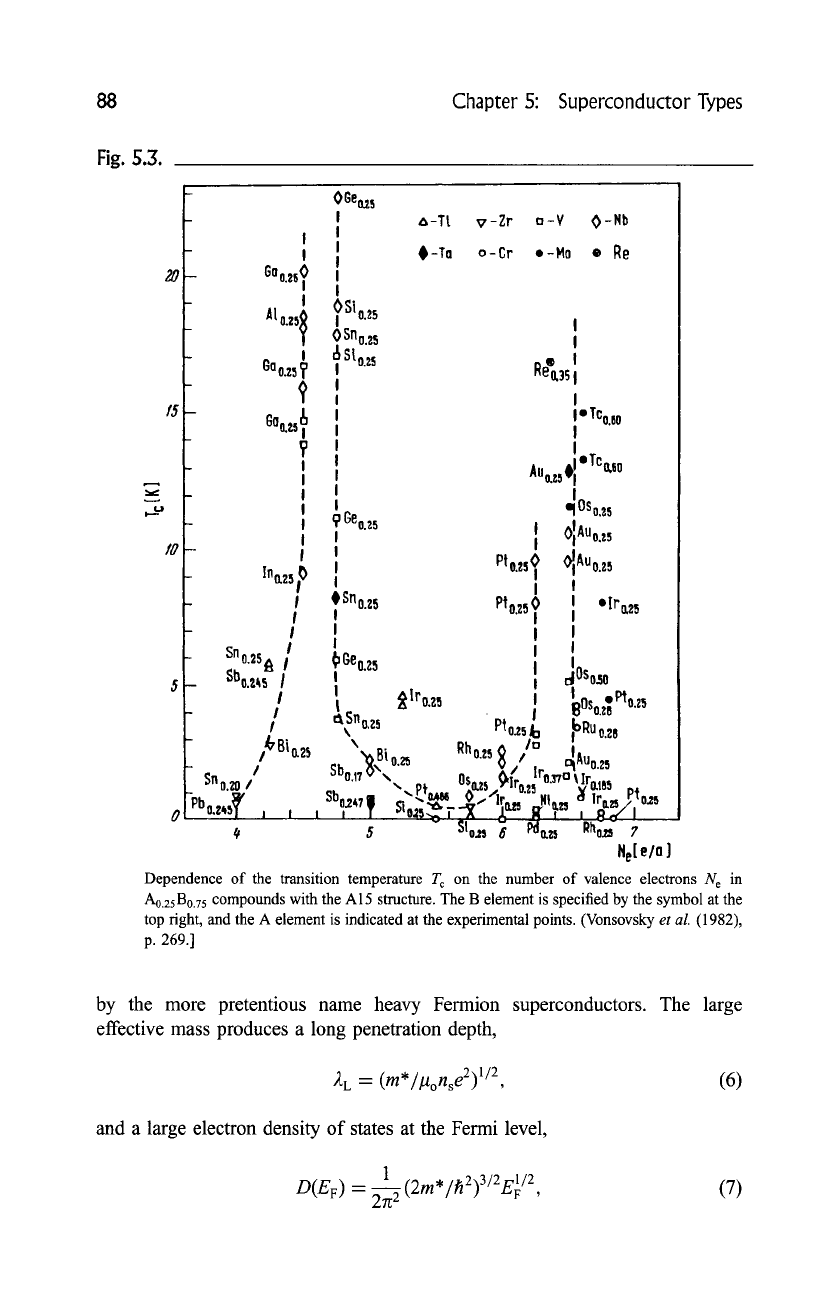
88 Chapter 5: Superconductor Types
Fig. 5.3.
I,.._ IJ
I
l
G0o.25 tO
I
At o.25~
l
oo o.z~ ?
?
Gao.ts i ~
I
I
I
I
t
I
Intt251
~
I
t
!
- Sn o.25 ]
~bo.z~ I
5-
I
- I
/
- ~Bio.~ 5
- /
Sn o.zo I
I~0 0"45T I I I
t/
OGeo.z~
I ~-Tt v-Zr a-Y O-Nb
I
I #-To o-Cr o-Ho 9 Re
I
I
I
IOSi o.25 I
0 Sn o 2~ l
sloi's Re~35 t
I I
I I
I I * TCo.eo
I I
I
Ii
Au o.z5 4) i 9 Te o.eo
I I
I =lOSo,2s
Y
Ge~ I OtlAU o.z5
I I
I
I Pto.,,O I ~lAUo.z,
I I I
$
l
Sn~ PI~ ?
II
oIr~z ~
I I I
I I I
I
~Ge~ I dOSo~o
I
'-,\
o.zs P~o.~ ~ ~Ruo..
\~Bio.z+ Rho.z5 0 /It+ IA '
?/ ,.. ~ uo.z~
SbojT~"',,, osr <?Iro~'o.r,~ o,
,,,. ,. Pfo~
~uo~47t ~ "~s,
~.-/ir..."
Hr,.
•
lrctzsr~o~-5
5 v
510.2s
6 Pdo.zs Rho~
7
He[ e/o ]
Dependence of the transition temperature T c on the number of valence electrons N e in
Ao.25B0.75
compounds with the A15 structure. The B element is specified by the symbol at the
top right, and the A element is indicated at the experimental points. (Vonsovsky
et al.
(1982),
p. 269.]
by the more pretentious name heavy Fermion superconductors. The large
effective mass produces a long penetration depth,
)t L -- (m*/#onse2) 1/2,
(6)
and a large electron density of states at the Fermi level,
D(EF) -
~-~2(2m*/h
(7)
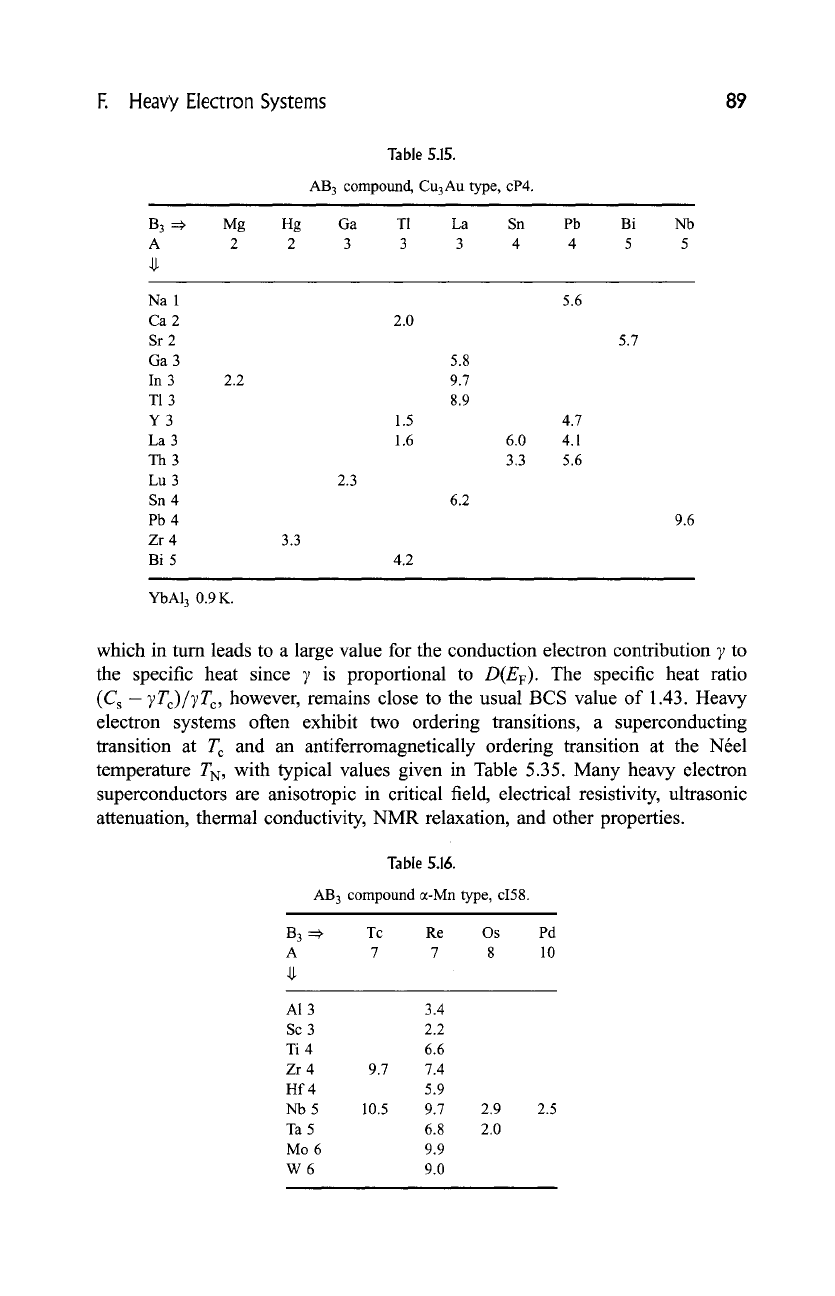
E HeaW Electron Systems 89
Table 5.15.
AB 3 compound, Cu3Au type, cP4.
B 3 ==~
A
Mg Hg Ga T1 La Sn Pb Bi Nb
2 2 3 3 3 4 4 5 5
Na 1
Ca 2
Sr 2
Ga 3
In 3
T1 3
Y3
La 3
Th3
Lu 3
Sn 4
Pb 4
Zr 4
Bi 5
2.2
3.3
2.3
2.0
5.8
9.7
8.9
5.6
1.5 4.7
1.6 6.0 4.1
3.3 5.6
6.2
4.2
5.7
9.6
YbA13 0.9 K.
which in turn leads to a large value for the conduction electron contribution 7 to
the specific heat since 7 is proportional to D(EF). The specific heat ratio
(C s -
7Tc)/TT c,
however, remains close to the usual BCS value of 1.43. Heavy
electron systems often exhibit two ordering transitions, a superconducting
transition at T c and an antiferromagnetically ordering transition at the N6el
temperature T N, with typical values given in Table 5.35. Many heavy electron
superconductors are anisotropic in critical field, electrical resistivity, ultrasonic
attenuation, thermal conductivity, NMR relaxation, and other properties.
Table
5.16.
AB 3 compound c~-Mn type, ci58.
B 3 ==~
A
Tc
Re Os Pd
7 7 8 10
A1 3 3.4
Sc 3 2.2
Ti
4 6.6
Zr 4 9.7 7.4
Hf 4 5.9
Nb 5 10.5 9.7 2.9 2.5
Ta
5 6.8 2.0
Mo 6 9.9
W 6 9.0
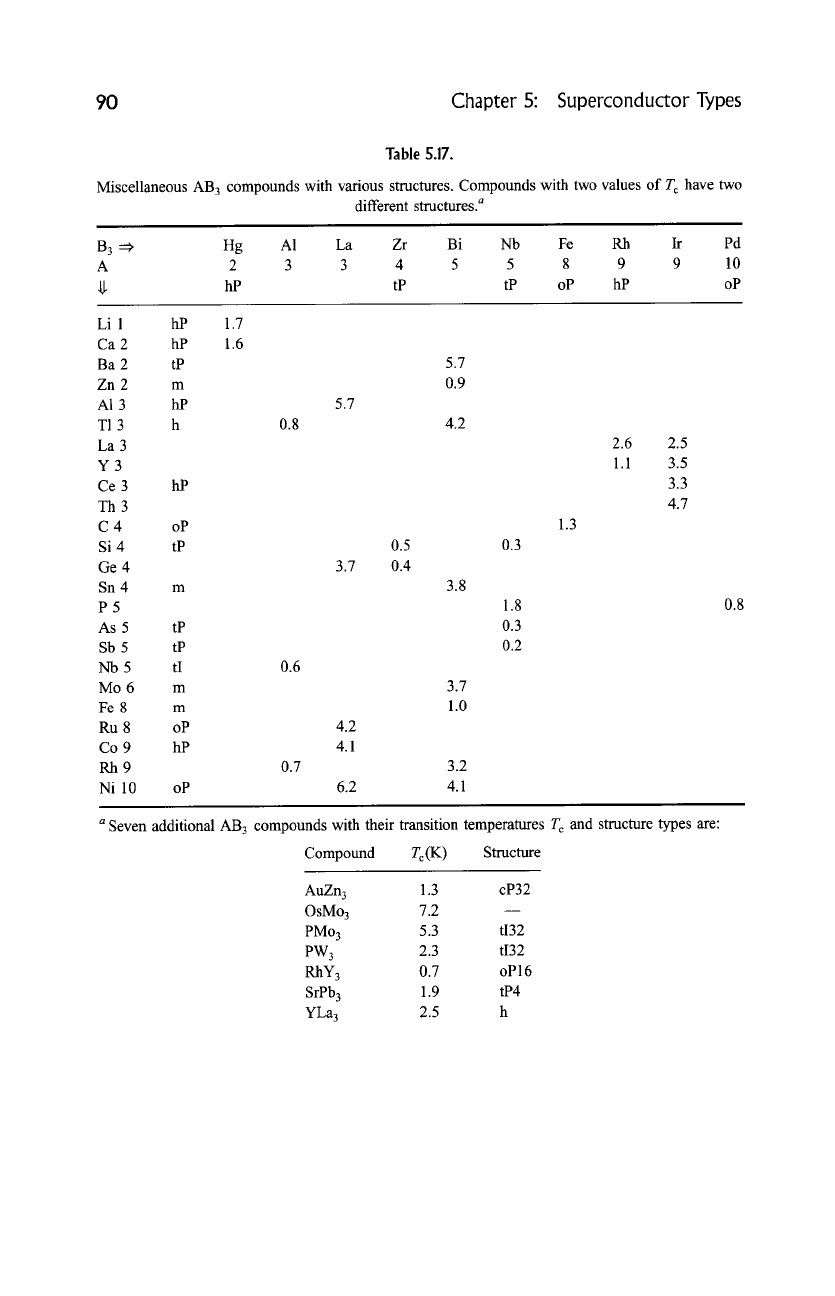
90 Chapter
5:
Superconductor Types
Table .5.17.
Miscellaneous AB 3 compounds with various structures. Compounds with two values of T c have two
different structures, a
B 3 :=~ Hg A1 La Zr Bi Nb Fe Rh Ir Pd
A 2 3 3 4 5 5 8 9 9 10
~. hP tP tP oP hP oP
Li 1 hP
Ca 2 hP
Ba 2 tP
Zn 2 m
A1 3 hP
T1 3 h
La 3
Y3
Ce 3 hP
Th 3
C 4 oP
Si 4 tP
Ge 4
Sn 4 m
P5
As 5 tP
Sb 5 tP
Nb 5 tI
Mo 6 m
Fe 8 m
Ru 8 oP
Co 9 hP
Rh9
Ni 10 oP
1.7
1.6
5.7
5.7
0.9
0.8 4.2
0.5 0.3
3.7 0.4
4.2
4.1
0.6
3.8
3.7
1.0
0.7 3.2
6.2 4.1
1.8
0.3
0.2
1.3
2.6
1.1
2.5
3.5
3.3
4.7
0.8
a
Seven additional AB 3 compounds with their transition temperatures T c and structure types are:
Compound Tr (K) Structure
AuZn 3 1.3 cP32
OsMo 3 7.2
PMo 3 5.3 ti32
PW 3 2.3 ti32
RhY 3 0.7 oP16
SrPb 3 1.9 tP4
YLa 3 2.5 h
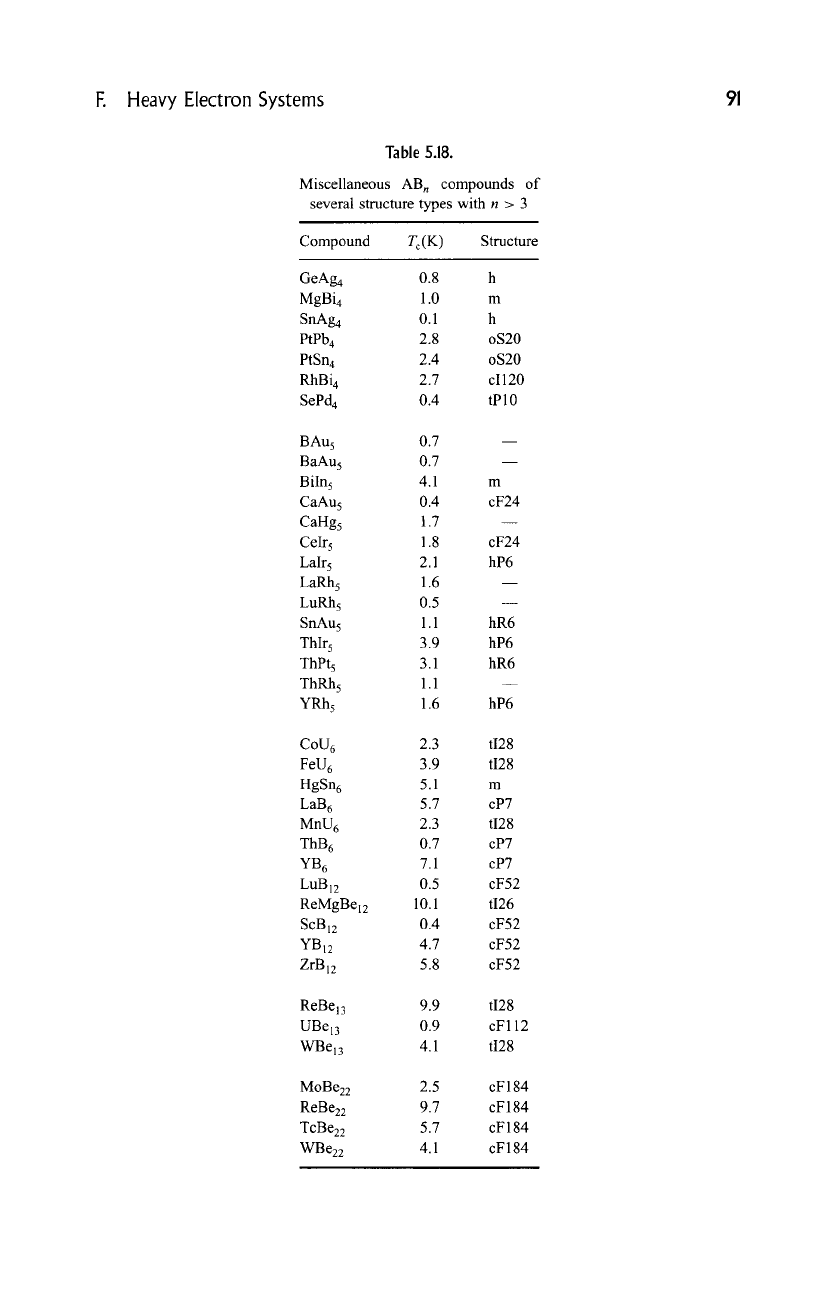
F.
Heavy Electron Systems
91
Table 5.18.
Miscellaneous AB n compounds of
several structure types with n > 3
Compound T c (K) Structure
GeAg 4 0.8 h
MgBi 4 1.0 m
SnAg 4 0.1 h
PtPb 4 2.8 oS20
PtSn 4 2.4 oS20
RhBi 4 2.7 cI120
SePd 4 0.4 tP10
BAu 5 0.7
BaAu 5 0.7
BiIn 5 4.1 m
CaAu 5 0.4 cF24
CaHg 5 1.7
CeIr 5 1.8 cF24
Lair 5 2.1 hP6
LaRh 5 1.6
LuRh 5 0.5
SnA% 1.1 hR6
Thlr 5 3.9 hP6
ThPt 5 3.1 hR6
ThRh 5 1.1
YRh 5 1.6 hP6
CoU 6 2.3 ti28
FeU 6 3.9 ti28
HgSn 6 5.1 m
LaB 6 5.7 cP7
MnU 6 2.3 ti28
ThB 6 0.7 cP7
YB 6 7.1 cP7
LuBl2 0.5 cF52
ReMgBel2 10.1 ti26
ScB12 0.4 cF52
YB12 4.7 cF52
ZrB12 5.8 cF52
ReBel3 9.9 ti28
UBe13 0.9 cF112
WBe13 4.1 ti28
MoBe22 2.5 cF 184
ReBe22 9.7 cF184
TcBe22 5.7 cF184
VCBez2 4.1 cF 184
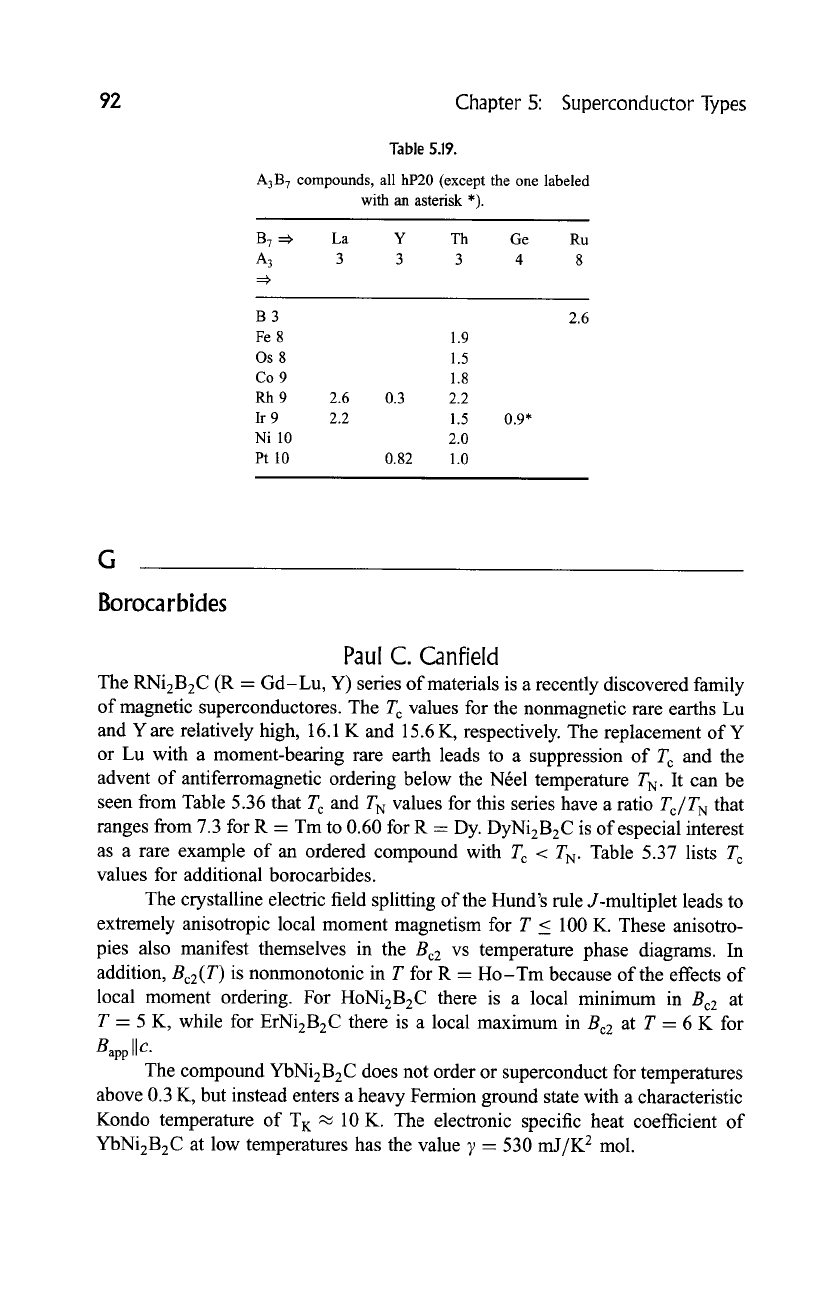
92
Chapter 5: Superconductor Types
Table 5.19.
A3B 7 compounds, all hP20 (except the one labeled
with an asterisk *).
B 7 :=~ La Y Th Ge Ru
A 3 3 3 3 4 8
=~
B3
Fe 8 1.9
Os 8 1.5
Co 9 1.8
Rh 9 2.6 0.3 2.2
Ir 9 2.2 1.5
Ni 10 2.0
Pt 10 0.82 1.0
0.9*
2.6
G
Borocarbides
Paul C. Canfield
The RNi2B2C (R - Gd-Lu, Y) series of materials is a recently discovered family
of magnetic superconductores. The Tr values for the nonmagnetic rare earths Lu
and Y are relatively high, 16.1 K and 15.6 K, respectively. The replacement of Y
or Lu with a moment-beating rare earth leads to a suppression of Tr and the
advent of antiferromagnetic ordering below the Nrel temperature T N. It can be
seen from Table 5.36 that Tr and T N values for this series have a ratio
Tc/T N
that
ranges from 7.3 for R - Tm to 0.60 for R - Dy. DyNi2B2C is of especial interest
as a rare example of an ordered compound with T~ < TN. Table 5.37 lists Tr
values for additional borocarbides.
The crystalline electric field splitting of the Hund's rule J-multiplet leads to
extremely anisotropic local moment magnetism for T < 100 K. These anisotro-
pies also manifest themselves in the
Be2
vs temperature phase diagrams. In
addition, Bc2(T ) is nonmonotonir in T for R - Ho-Tm because of the effects of
local moment ordering. For HoNi2B2C there is a local minimum in Be2 at
T -- 5 K, while for ErNi2B2C there is a local maximum in Br at T - 6 K for
Bapp ]lc.
The compound YbNi2B2C does not order or superconduct for temperatures
above 0.3 K, but instead enters a heavy Fermion ground state with a characteristic
Kondo temperature of T~: ~ 10 K. The electronic specific heat coefficient of
YbNi2B2C at low temperatures has the value V - 530 mJ/K 2 mol.
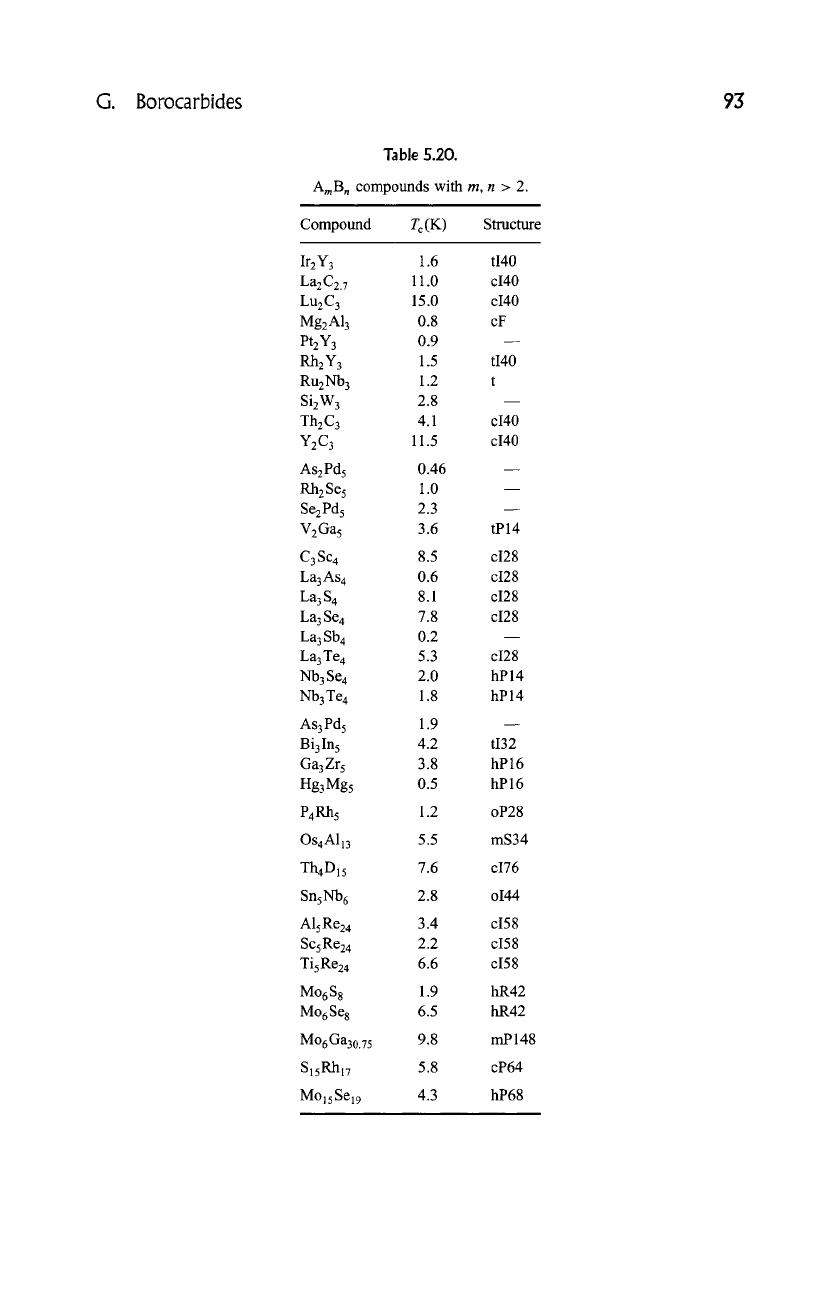
G. Borocarbides 93
Table S.20.
AraB n compounds with m, n > 2.
Compound T~(K) Structure
Ir2 Y3 1.6 tI40
La2 C2. 7 11.0 ci40
Lu2C 3 15.0 ci40
Mg2A13 0.8 cF
Pt2Y 3 0.9
Rh2Y 3 1.5 tI40
Ru2Nb 3 1.2 t
Si2W 3 2.8
Th2 C3 4.1 ci40
Y2C3 11.5 ci40
As2Pd 5 0.46
Rh2Se 5 1.0
SezPd 5 2.3
V2 Gas 3.6 tP 14
C3Sc 4 8.5 ci28
La3As 4 0.6 ci28
La3S 4 8.1 ci28
La3Se 4 7.8 ci28
La3Sb 4 0.2
La 3 Te 4 5.3 ci28
Nb 3 Se n 2.0 hP 14
Nb3Te 4 1.8 hP14
As3Pd 5 1.9
Bi3In 5 4.2 ti32
Ga 3 Zr 5 3.8 hP 16
Hg3Mg 5 0.5 hP16
PaRh5 1.2 oP28
OsaAl13 5.5 mS34
Th4D15 7.6 ci76
SnsNb 6 2.8 o144
A15Re24 3.4 ci58
Sc5Re24 2.2 ci58
TisRe24 6.6 ci58
Mo6S 8 1.9 hR42
Mo6Se 8 6.5 hR42
Mo6Ga30.75 9.8 mP148
Sl5Rhl7 5.8 cP64
MolsSel9 4.3 hP68
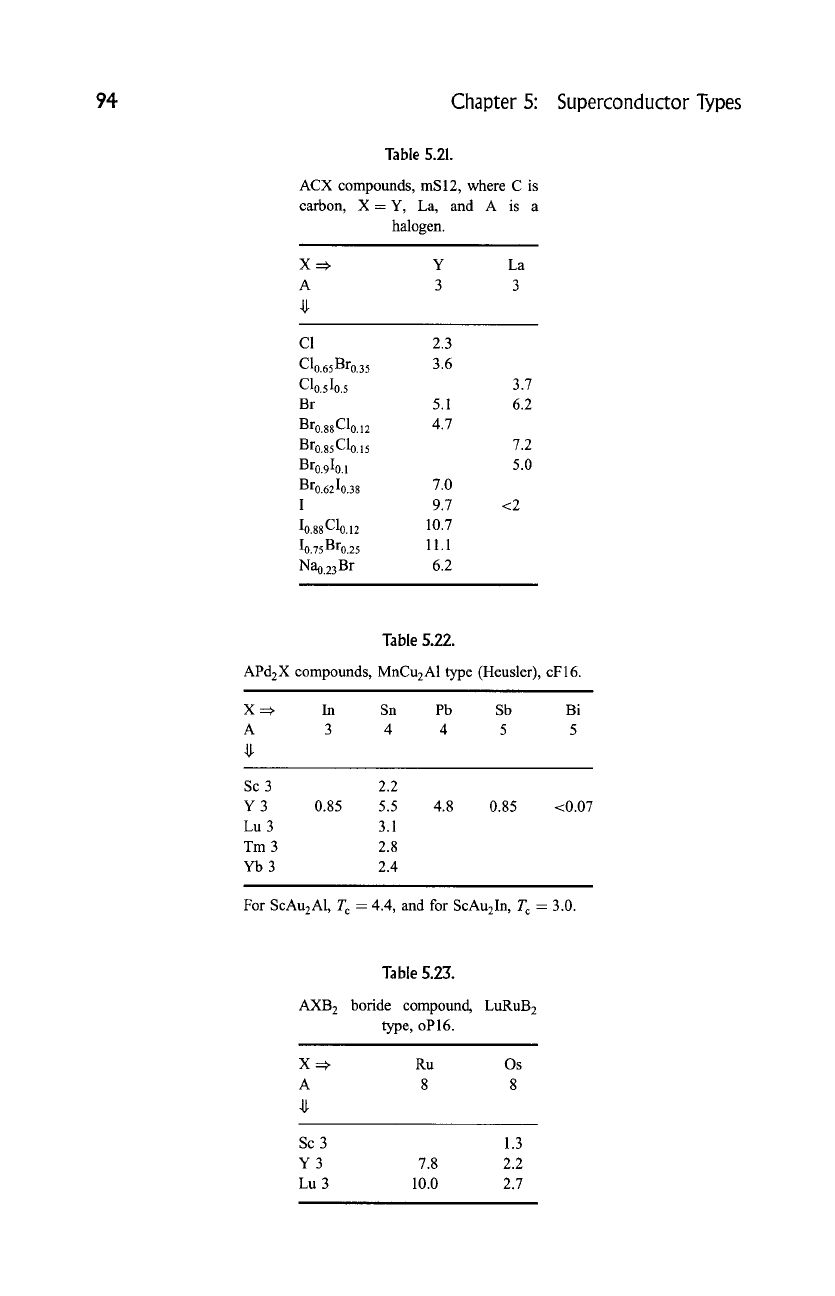
94
Chapter 5: Superconductor Types
Table 5.21.
ACX compounds, mS 12, where C is
carbon, X=Y, La, and A is a
halogen.
X =~ Y La
A 3 3
C1 2.3
Clo.65Bro.35 3.6
Clo.5Io.5
Br 5.1
Bro.88Clo.12 4.7
Bro.85Clo.15
Bro.9Io.1
Bro.62Io.38 7.0
I 9.7
Io.88Clo.12 10.7
Io.75Bro.25 11.1
Nao.23Br 6.2
3.7
6.2
7.2
5.0
<2
Table
5.22.
APd2X compounds, MnCu2A1 type (Heusler), cF16.
X =~ In Sn Pb Sb Bi
A 3 4 4 5 5
Sc 3 2.2
Y 3 0.85 5.5 4.8
Lu 3 3.1
Tm 3 2.8
Yb 3 2.4
0.85 <0.07
For ScAu2A1, T c = 4.4, and for ScAu2In, T c = 3.0.
Table 5.23.
AXB 2 boride compound, LuRuB 2
type, oP16.
X =~ Ru Os
A 8 8
Sc 3 1.3
Y 3 7.8 2.2
Lu 3 10.0 2.7
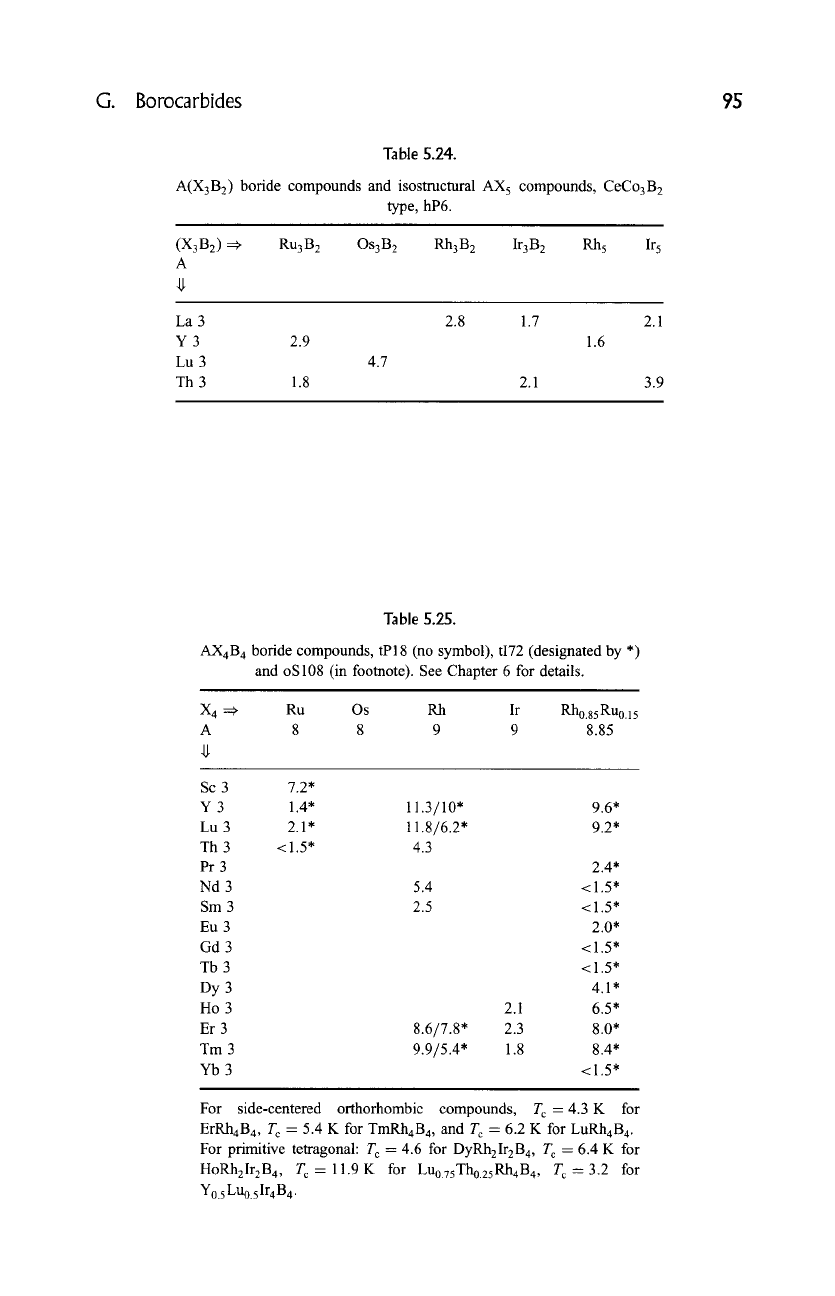
G.
Borocarbides 95
Table 5.24.
A(X3B2) boride compounds and isostructural AX 5 compounds, CeCo3B e
type, hP6.
(X3B2)
A
Ru3 B2 Os3 B2 Rh3 B2 Ir3 B2 Rh5 Ir5
La 3
Y3
Lu 3
Th 3
2.9
1.8
4.7
2.8 1.7 2.1
1.6
2.1 3.9
Table
5.25.
AX4B 4 boride compounds, tP18 (no symbol), ti72 (designated by *)
and oS 108 (in footnote). See Chapter 6 for details.
X 4 :::ff
Ru Os Rh Ir Rh0.85 Ru0.15
A 8 8 9 9 8.85
Sc 3 7.2*
Y 3 1.4" 11.3/10" 9.6*
Lu 3 2.1" 11.8/6.2" 9.2*
Th 3 < 1.5" 4.3
Pr 3 2.4*
Nd 3 5.4 < 1.5"
Sm 3 2.5 < 1.5"
Eu 3 2.0*
Gd 3 < 1.5"
Tb 3 <1.5"
Dy 3 4.1"
Ho 3 2.1 6.5*
Er 3 8.6/7.8* 2.3 8.0*
Tm 3 9.9/5.4* 1.8 8.4*
Yb 3 <1.5"
For side-centered orthorhombic compounds, T c = 4.3 K for
ErRhaB4, T c -- 5.4 K for TmRhaB4, and Tc -- 6.2 K for LuRhaB 4.
For primitive tetragonal: T c = 4.6 for DyRh2Ir2B4, T c = 6.4 K for
HoRh2Ir2B 4, T c = 11.9 K for Luo.75Th0.25Rh4B4, T c = 3.2 for
Y0.5 Lu0.5 Ira B4.
